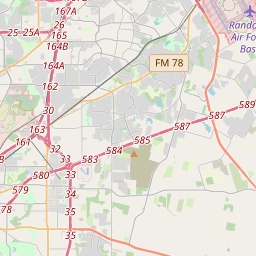Fort Sam Houston Museum
2108 Wilson Way, Fort Sam Houston Texas 78234(210) 221-1886
Open: Tuesday through Friday, 10:00 a.m. to 4:00 p.m. Saturday, noon to 4:00 p.m.







Established: 1967
Texas is home to the world's largest bat colony. The Bracken Bat Cave, near San Antonio, is home to millions of Mexican free-tailed bats.
During the Texas Revolution in 1836, the Battle of the Alamo took place, where a small group of Texan defenders valiantly fought against Mexican forces. Although the defenders ultimately lost, their bravery and sacrifice galvanized the Texan cause. Soon after, the Republic of Texas was established, and Bexar County was officially created in 1837, named after San Antonio de Béxar.
Bexar County played a vital role in the westward expansion of the United States. It became part of the United States when Texas joined as the 28th state in 1845. The county saw significant growth with the construction of railroads, the establishment of military bases like Fort Sam Houston, and the influx of European immigrants. In 1968, HemisFair '68 brought international attention to the county, showcasing its rich cultural heritage and attracting visitors from around the world. Today, Bexar County is known for its vibrant tourism industry, robust military presence, renowned healthcare institutions, and prestigious educational establishments.
Bexar County Timeline
This timeline provides a condensed summary of the historical journey of Bexar County, Texas.
Pre-19th Century: The region that would become Bexar County was inhabited by various Native American tribes, including the Coahuiltecan and Lipan Apache.
1718: The Spanish established the Mission San Antonio de Valero, known today as the Alamo, in what is now downtown San Antonio. This marked the beginning of Spanish colonization in the area.
1821: Mexico gained independence from Spain, and the region came under Mexican control.
1836: The Battle of the Alamo took place during the Texas Revolution, where a small group of Texan defenders fought against Mexican forces. Though the defenders were ultimately defeated, their resistance became a symbol of Texas independence.
1837: The Republic of Texas officially established Bexar County, naming it after San Antonio de Béxar, the former Spanish name for the area.
1845: Texas joined the United States as the 28th state.
1861-1865: During the American Civil War, Bexar County remained part of the Confederacy.
Late 19th-early 20th century: The county saw growth and development with the expansion of railroads, the establishment of military bases like Fort Sam Houston, and the arrival of European immigrants.
1968: HemisFair '68, a world's fair, was held in San Antonio, bringing national and international attention to the city and the county.